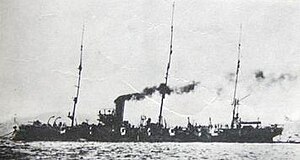Japanese cruiser Chiyoda

Chiyoda around 1900
|
|
| History | |
|---|---|
|
|
|
| Name: | Chiyoda |
| Ordered: | 1888 Fiscal Year |
| Builder: | J & G Thomson (From 1899 John Brown & Company), United Kingdom |
| Laid down: | 4 December 1888 |
| Launched: | 3 June 1890 |
| Completed: | 1 January 1891 |
| Decommissioned: | 28 February 1927 |
| Fate: | Expended as target 5 August 1927 |
| General characteristics | |
| Type: | Cruiser |
| Displacement: | 2,439 long tons (2,478 t) |
| Length: | 94.49 m (310 ft 0 in) w/l |
| Beam: | 12.81 m (42 ft 0 in) |
| Draught: | 4.27 m (14 ft 0 in) |
| Propulsion: | 2-shaft vertical triple expansion, 6 locomotive boilers, 5,678 hp (4,234 kW) |
| Speed: | 19 knots (22 mph; 35 km/h) |
| Complement: | 350 |
| Armament: |
|
| Armour: |
|
Chiyoda (千代田?) was a cruiser of the Imperial Japanese Navy, which served in the First Sino-Japanese War, Russo-Japanese War and World War I.
Chiyoda was ordered by the Meiji government as a replacement for the ill-fated Unebi, and paid for with insurance money received from the French government after that ship disappeared without a trace somewhere in the South China Sea en route to Japan. However, unwilling to use a French shipyard after the Unebi disaster, the Imperial Japanese Navy placed its order in 1889 to J & G Thomson of Glasgow, Scotland. Construction was supervised by Arai Yukan and by Ijuin Gorō and on 11 April 1891, Chiyoda arrived safely at Yokosuka. On 5 September 1892, command of Chiyoda was assigned to Captain (later Fleet Admiral) Prince Arisugawa Takehito.
Chiyoda was a ‘belted cruiser’ based on a much scaled-down version of the Royal Navy’s Nelson-class cruisers. The hull was made of 84 watertight compartments, protected with Harvey armor. Originally designed to carry 12.6 inch Canet guns, the plan was abandoned due to excessive top weight. Instead, the design was changed so that her main battery consisted of ten QF 4.7 inch /40 naval guns in single mounts, mounted one each in the bow and stern, and four on each side in sponsons. The use of the Elwick quick-firing technology resulted in an increase in the rate of fire by six-fold over previous cruiser designs. Her secondary battery consisted of 14 QF 3 pounder Hotchkiss and three 11-mm, 10-barrel Nordenfelt guns. She was also equipped with three 356 mm (14.0 in) Whitehead torpedo tubes mounted on the main deck. As was standard practice at the time, the prow was reinforced for ramming.
...
Wikipedia
